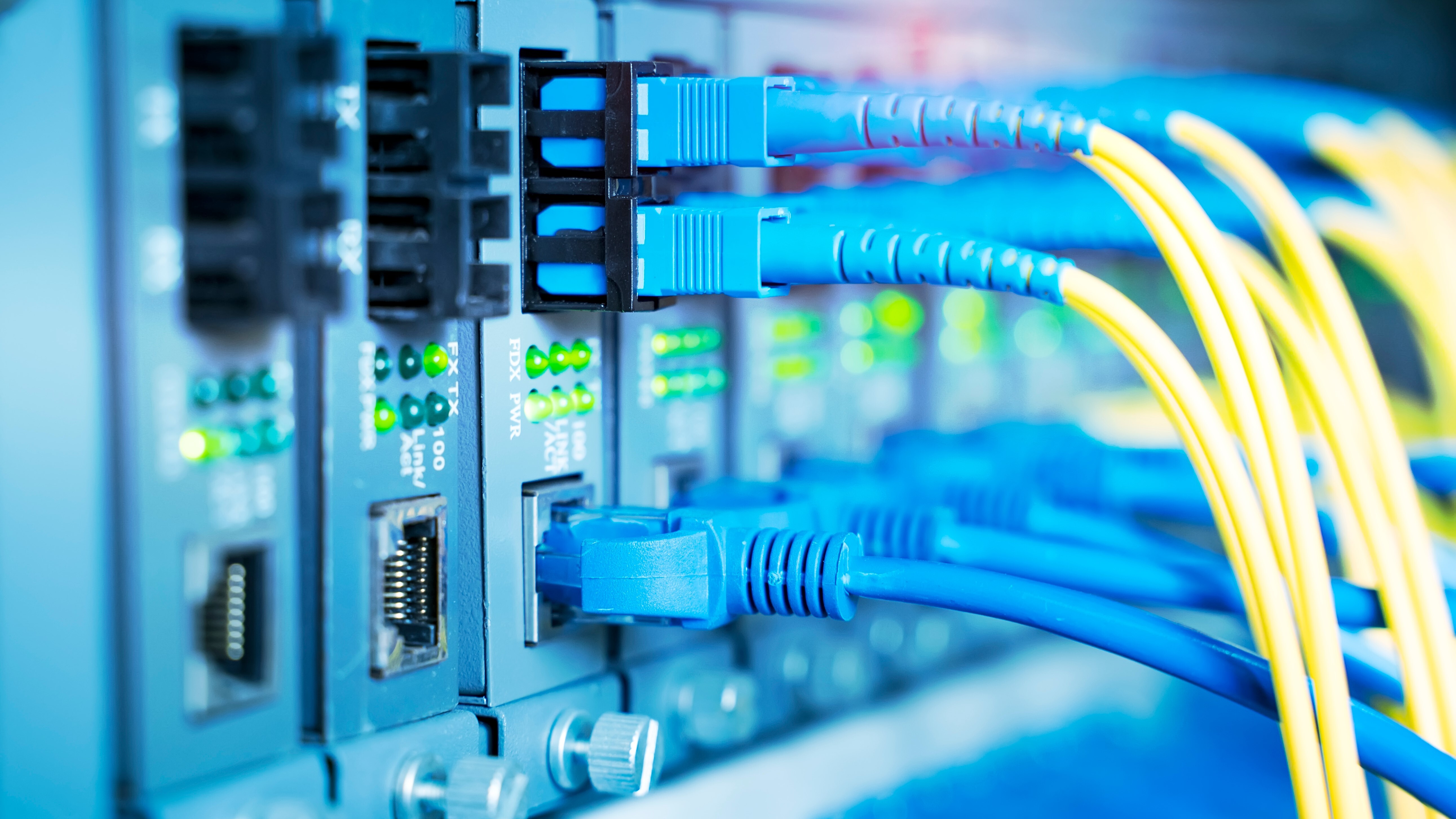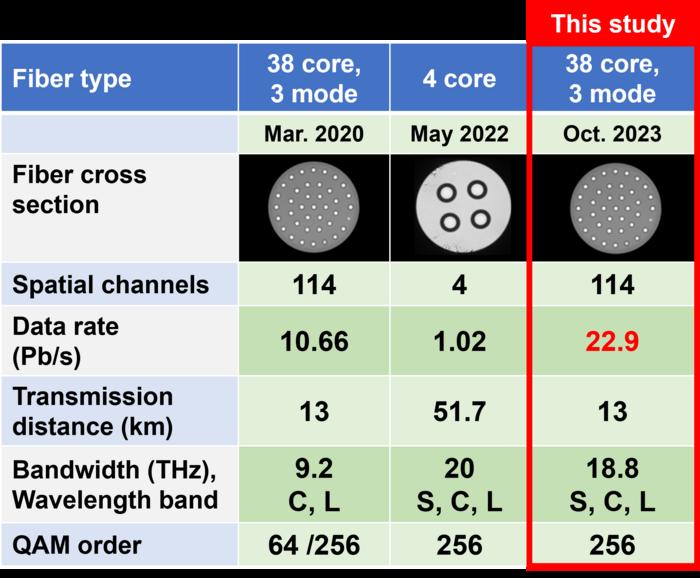Japanese Institute breaks optical fiber speed record with 22.9 petabits per second — 1,000 times faster than existing cables

A team of researchers from the National Institute of Information and Communications Technology (NICT), Eindhoven University of Technology, and the University of L’Aquila have achieved a groundbreaking transmission that demonstrates the possibility of transmitting up to 22.9 petabits per second (Pb/s) through a single optic cable composed of multiple fibers. This is a significant increase in transmission capacity, as the previous world record was 10.66 Pb/s.
The old record was broken last June, with 1.8 Pb/s by researchers from the Technical University of Denmark (DTU) and Chalmers University of Technology in Gothenburg, Sweden. Then it was broken multiple times in the following months.

The researchers achieved this breakthrough by combining the latest research technologies with Space Division Multiplexing (SDM) and Wavelength Division Multiplexing (WDM). SDM uses multiple multicore fibers and various transmission technologies to work with over 100 spatial channels, which are then combined with multi-bandwidth WDM. The researchers merged this 38-core, three-mode cable through a multi-band compatible MIMO receiver.
Each core is capable of transmitting data between 0.3 to 0.7 Pb/s. With optimized coding, achieving speeds of up to 24.7 PB/s may be possible. This is the first time that different multiplexing techniques have been combined, resulting in a major advancement in data transmission technology.
The research findings were submitted and accepted at Glasgow's 49th European Conference on Optical Communications. Although the technology is ready to be integrated into the existing global optical connection infrastructure, it will require significant upgrades to the current telecommunication centers that use ultra-large capacity optical fibers.
To put it in plain words, this new infrastructure could handle up to three times the amount of data traffic through these cables once deployed, which is 1,000 times more than the currently deployed optic cables. It's also a question of when the new cables and infrastructure might be deployed, as many such records were broken this year, and also which one of these approaches will be deemed most feasible.
Research breakthroughs are crucial to keep up with the high rate of internet consumption worldwide. Establishing records like this with the merit of multiple institutions and researchers, along with the cooperation of several telecommunications players, is likely to encourage investment and quick deployment within the existing ecosystem.
Get Tom's Hardware's best news and in-depth reviews, straight to your inbox.

Roshan Ashraf Shaikh has been in the Indian PC hardware community since the early 2000s and has been building PCs, contributing to many Indian tech forums, & blogs. He operated Hardware BBQ for 11 years and wrote news for eTeknix & TweakTown before joining Tom's Hardware team. Besides tech, he is interested in fighting games, movies, anime, and mechanical watches.
-
George³ I read, read, read and didn't figure out.Reply
It's as if this article is assembled from a title and separate sentences written by different people and contradicting each other throughout the text. They didn't get along. One claims all the speed through a single optical fiber, and another that it is through an entire cable bundle of several dozen optical fibers. -
PEnns Japan? The universities in the article are in the Netherlands and Italy.Reply
Anyway, in many parts of the US peoples' only access to the internet is a DSL cable....they can only dream of such speeds! And we're not talking about rural areas only, but places just a couple of miles outside major cities!
Yeah, I lived till 6 months ago in one where 1 mbps was the top speed on a good day! Download speed was about 700 kbps.....and that amazing speed cost "only" $90 / month. -
HaninTH ReplyPEnns said:Anyway, in many parts of the US peoples' only access to the internet is a DSL cable....they can only dream of such speeds! And we're not talking about rural areas only, but places just a couple of miles outside major cities!
Yeah, I lived till 6 months ago in one where 1 mbps was the top speed on a good day! Download speed was about 700 kbps.....and that amazing speed cost "only" $90 / month.
It's a tragedy of our greedy capitalist overlords that they hold back our internet access so drastically. There's unlit fiber all over the place, but these maniacs refuse to utilize it because they can't be ensured a captured revenue stream until they hit a certain density threshold.
Maybe we need to revisit the notion that corporations should only exist to generate revenue and add a little customer support mantra into the mix so that there's a reasonable blend of revenue to service.
But this is a pipe dream.... -
JarredWaltonGPU Reply
It's literally the first sentence of the abstract, as well as the article:PEnns said:Japan? The universities in the article are in the Netherlands and Italy.
"Researchers from the National Institute of Information and Communications Technology (NICT, President: TOKUDA Hideyuki, Ph.D.), in collaboration with the Eindhoven University of Technology and University of L’Aquila demonstrated a record-breaking data-rate of 22.9 petabits per second using only a single optical fiber, which was more than double our previous world record of 10.66 petabits per second."
So yes, it's a Japanese Institute, in collaboration with Netherlands and Italy universities. -
COLGeek Are these the new arteries of the AI overlords that await the destruction of humanity that so many are losing their minds over?Reply
:rolleyes: -
George³ Obviously the text will need to be revised, otherwise some of the statements do not match the graph included and that a single optical fiber has a performance of 0.3 to 0.7 petabits.Reply -
TJ Hooker Reply
Which exact statements? It's a single cable with 38 cores. Each core can transmit between 0.3 to 0.7 Pb/s, with the average per-core data rate being 0.6 Pb/s (22.9 Pb/s divided by 38).George³ said:Obviously the text will need to be revised, otherwise some of the statements do not match the graph included and that a single optical fiber has a performance of 0.3 to 0.7 petabits. -
George³ Reply
Hahaha. The problem may also come from a misunderstanding of terminology. The difference between a single optical fiber and the cable used is apparently incomprehensible. The claim from the title and from some sentences in the text is as if someone split the cable lengthwise, removed just one of the fibers and let all the traffic go through it.TJ Hooker said:Which exact statements? It's a single cable with 38 cores. Each core can transmit between 0.3 to 0.7 Pb/s, with the average per-core data rate being 0.6 Pb/s (22.9 Pb/s divided by 38). -
TJ Hooker Reply
I'm not sure where the "three times" came from. Maybe a typo/misunderstanding of the following statement from the source article?Admin said:To put it in plain words, this new infrastructure could handle up to three times the amount of data traffic through these cables once deployed, which is 1,000 times more than the currently deployed optic cables.
" ultra-large-capacity optical fibers will be needed in the future, where the data traffic demand is expected to increase by 3 orders of magnitude (x1,000 times)" -
shpankey Limitations like this have nothing to do with FoC itself but the equipment transmitting and receiving on either end.Reply